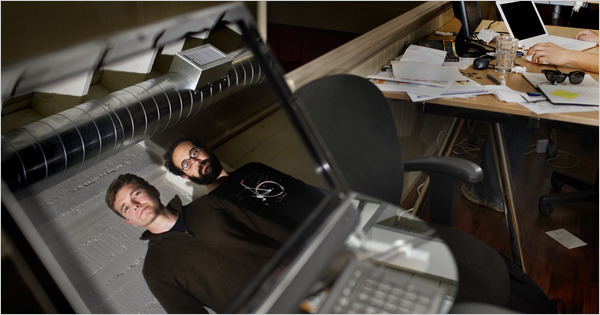Jonas Ketterle, a top mechanical engineering student at Stanford University, and his colleague Mike Lin, a sustainable-design lecturer at Stanford and Yale, are studying how 150 million people in developing countries make do using electricity from hacked car batteries.
An estimated 1.5 billion people worldwide live without dependable electric power. In places like Kenya, lead-acid batteries are affixed to bare wires and used to charge cellphones, radios and lights. By collecting baseline data on how these batteries are used, the two researchers hope to show that an improved battery system can hasten rural electrification.
But Mr. Ketterle, 23, and Mr. Lin, 28, struggle to pay for their research. The grant-making structure of their field and of the institutions in which they were trained means that small-scale research grants of less than $50,000 — the kind that could support new researchers with untested, independent ideas — are limited. That is where Eureka Fund comes in.
Eureka Fund, based in San Francisco, is one of a handful of new nonprofit organizations created to give the general public an opportunity to pay for scientific research that is not fully supported by government or private sources. They are part of a fledgling movement to take the idea of crowd-sourcing and crowd-financing, which has worked in arenas like small business and education, to scientific research.
And while the notion of citizens’ directly donating to public research that could ultimately produce profits may raise questions, several ventures are entering the field. Two other Web sites — Sciflies.org, based in St. Petersburg, Fla., and FundScience.org, in Pittsburgh — plan to roll out their donation platforms to finance independent research by this summer.
Eureka Fund, the first to accept donations, allows the public to give a few dollars to help young scientists at the University of California, Berkeley, and Stanford with their research projects.
“I do think there’s value in having a variety of funding sources, particularly for the risky stuff,” Franklin M. Orr Jr., a professor of energy resources engineering at Stanford, said when the project was described to him. “You can get a grant for a significant amount of money, but the whole review process is pretty risk-averse.”
Paul C. McIntyre, a professor of materials science and engineering at Stanford, was intrigued by the Eureka Fund model but slightly concerned about a possible lack of controls.
“Unless a professor is party to these proposals and is indeed really the one who is given the responsibility by the university to submit them,” Dr. McIntyre said, “there’s no telling what kind of abuses could happen in their labs. Professors would never go along with it because they’re liable for any safety or ethical violations that might occur.”
The Eureka Fund site, operating on a trial basis since its start in December, still allows donations only to Mr. Ketterle and Mr. Lin’s project. Jason Blue-Smith, the organization’s founder, and Zach Berke, its technology director, want to measure the first project’s success before expanding. If the battery project reaches its $23,000 fund-raising goal, Eureka Fund will post new projects. So far, it have raised $1,300.
The crowd-financing concept is well established in the for-profit and education arenas. The Web site Kiva.org has raised more than $128 million in loans for small businesses in developing countries in the past four and a half years. The education charity DonorsChoose has collected more than $50 million online.
But Mr. Blue-Smith and Mr. Berke said financing science research was fraught with unique complexities.
“The idea behind Eureka Fund is to establish in some respects a paradigm shift on the funding ecosystems for scientific research,” Mr. Blue-Smith said. “We can augment the efforts of the government and these large foundations to meet this critical need, which are these early-stage ideas.”
While Eurekafund.org has started with one appeal, Mr. Blue-Smith said it would soon host an array of projects. The candidates would first be vetted by a half-dozen anonymous peer reviewers and then by a scientific advisory board that includes three established scientists. Mr. Blue-Smith said peer reviewers would be selected from scientists featured on Eurekafund.org; he is recruiting more board members.
All the projects lined up so far intend to solve problems in wind, transportation, water, solar and energy storage, and each needs less than $50,000. Donors can communicate directly with the scientists, who guarantee that the results will be made public in an academic journal or on the site. The suggested donation is $25.
Mr. Blue-Smith, a research fellow with the Genographic Project at the National Geographic Society, which studies the history of human migration, said that during public presentations audience members inevitably asked how to support his research.
“It no longer works to tell people stories,” he said. “What you have to do is allow them to help you write the story.”
Eureka Fund focuses on researchers still earning advanced degrees.
Government agencies and foundations spend tens of billions of dollars each year on research at universities, typically granting large sums to principal investigators, who use some of the money to support masters students and Ph.D. candidates. If a student comes up with a concept that falls outside a professor’s focus, however, money can be scarce.
“That model is not sufficient,” said Daniel M. Kammen, a professor in the energy and resources group at Berkeley and a Eureka Fund scientific adviser.
“The more you want to be interdisciplinary, break boundaries,” Dr. Kammen said, “the less well it works because those big grants help senior investigators who are in traditional areas.”
Dr. Kammen said one of his students obtained a $10,000 grant with his assistance and was then able to help the City of Berkeley design a plan to issue bonds to underwrite the up-front costs of energy-efficiency improvements and solar power installation for residential and commercial properties. A 2008 review of the National Science Foundation’s financing revealed that average annual grants were $145,000 and tended to go to researchers who earned doctorates more than seven years ago. The foundation supports 37,000 graduate students, usually by covering living expenses and tuition.
“Any opportunity for a student to find resources to pursue a topic of their own conception is an exciting idea,” said Joshua A. Chamot, a spokesman for the foundation. “But I’d say there are mechanisms within the existing framework that allow students to do projects, semi-independently, and on cutting-edge topics.”
The electrification project by Mr. Ketterle and Mr. Lin will ask Kenyans about the hacked car batteries — how often and when they use them and where they get them. The answers, they said, could help demonstrate to nonprofits, companies and governments that existing, but poorly used, distributed-power equipment could provide people with electricity and improve lives.
“We don’t know all the applications that could evolve,” Mr. Ketterle said.
The researchers have already come up with their own application: a human-powered energy generator and accompanying electronics that they say will extend a car battery’s life at least three times. They have founded a for-profit company, Fenix International, with an initial round of venture capital financing to develop and sell the product.
Eureka Fund money will not go toward their proprietary product research, but rather allow them to go public with the baseline research in Kenya.
The complexities of separating commercially valuable intellectual property from academic research and publishing are manageable, Mr. Blue-Smith said, adding, “This is a challenge scientists confront every day.”
Even when “the scientists have a relationship with an angel investor for a for-profit,” he said, “they still can’t get money to fund the really interesting, high-quality academic research that they believe in passionately.”
Eureka Fund directs all of the tax-deductible donations to a university, which in turn designates a principal investigator. The nonprofit will not own any patents or earn money from discoveries made with its help. All rights belong to the sponsoring university.
“As long as there’s enough communication,” Dr. McIntyre of Stanford said, “and people higher up within the university understand what’s been funded, who the students are, what they’re doing, then I think it could be done properly.”
This article was produced as a collaboration between the New York Times Bay Area Report and SFPublicPress.org, a nonprofit online news organization that covers public policy and social trends in San Francisco.









